| FINAL
REPORT - THE PASSIVE IGLOO PROJECT |
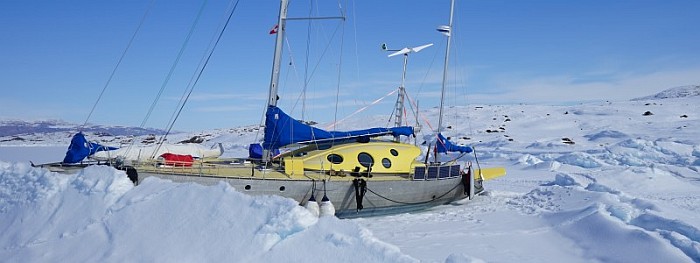
The passive igloo - Nanuq Greenland, spring 2016 (photo Peter
Gallinelli)
The
passive igloo project
Feedback
from an Arctic winter in a self-sufficient passive habitat
Peter
Gallinelli
Association ACAPELA, Geneva, Switzerland
© 2017
Table of contents

Abstract
The aim of the passive igloo project is to explore the possibilities
of creating an ecological and self-sufficient habitat by using
sound constructive measures and renewable energy resources
to guarantee thermal comfort in the most severe cold climates.
The passive igloo is a self-sufficient housing module
built into a polar exploration sailboat to accommodate a crew
of 2 to 6 people in conditions of severe cold to live and
work. In order to test the passive igloo, the boat was voluntarily
trapped in the ice in North West Greenland during the winter
of 2015-2016 and monitored during the 10 months of 'stationary
navigation'.

The passive igloo, the main living space
(photo Dorothée Adam)
Evidence has been provided that it is possible to create
an almost self-sufficient habitat while remaining simple and
affordable, even in the Arctic climate.
The biggest unforeseen event was the lack of wind that should
have been the main source of energy during the Arctic night.
Nevertheless the experiment could be concluded, making it
possible to point out that when a system requires very little
resources to operate it is intrinsically resilient and therefore
safe.
The passive igloo project goes beyond the issue
of energy self-sufficiency and also addresses complementary
aspects that are no less vital such as food, water or waste
management. It becomes a most complete laboratory of autonomy.

Location and climate
Located at 77.5 ° latitude north at a distance of 1200
km from the North Pole, the place for the winter camp provided
good chances of a harsh winter with temperatures that would
allow to test the systems to their ultimate limit, or even
beyond, with temperatures between -30° C and -40°
C and in the total absence of sun ... but also the remoteness
required to make self-sufficiency a real challenge and a total
commitment meaning that the systems would have to be absolutely
reliable.

Image background : NASA bluemarble (c)
The graph
below shows air temperatures and heating degree days from
mid-September 2015 to June 2016.

Winter 2015-2016 ; overview indoor
and outdoor air temperatures; HD: heating degree days 20/12
= 11800 dK; T-cabin / -3 = 7200 dK; for comparison in Central
Europe / Switzerland there are ~ 3000 heating degree days.
During the winter, the seawater temperature was almost constant
at -1.6° C, under the sea ice.
Given the very low temperatures, the air was extremely dry
which limits the snowfall: 20cm accumulated from the beginning
of the winter until March. Only with the warming of the spring,
rainfall added 30cm of fresh snow during the month of April.
At the location of the winter camp, winds were strongest
between September and October, punctuated by violent storms
with speeds in excess of 70 knots. Overall, the winds, however,
remained weak and weren't a sufficient and reliable enough
as a source of energy. Part of the contradiction lies in providing
a safe and sheltered place for the boat to stay and at the
same time exposed to run the wind generators.
Located far above the Arctic Circle, the sun is completely
absent from late October to mid-February and despite significant
twilights, solar energy during this period is close to zero.
However, this absence is compensated by a four-month summer
period during which the sun does not set, associated with
clear weather and enjoying a strong reverberation due to the
ice and snow, contributory to the use of solar energy.
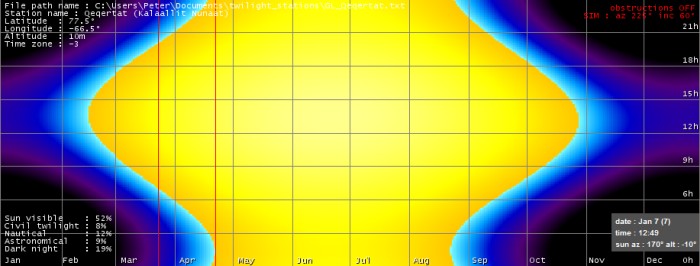
Twilight and sunshine hours in Qeqertat
- horizontal axis = date; vertical axis = hour (application
'twilight' - Peter Gallinelli)

Monitoring
In order to provide not only qualitative but also quantitative
feedback, a monitoring system was installed. It consisted
of two Campbell CR1000 automatic acquisition units equipped
with ad-hoc sensors and a microcontroller.
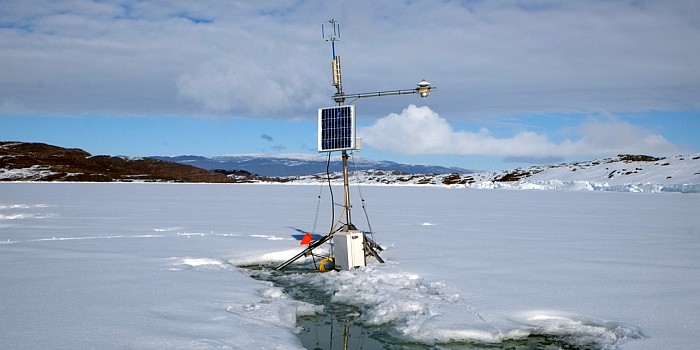
The climate station; at the end of winter
the ice begins to melt away (photo Peter Gallinelli)
Outside - weather station :
- air temperature
- global horizontal and reflected solar radiation (albedo)
- ice surface temperature and water temperature at 3m depth
- heat flux through ice shelf
- wind direction and speed
Inside :
- living quarters, cabin and bilge air temperature
- inlet and exhaust air temperatures of ventilation system
- relative humidity of cabin air
- heat flux sensor (mobile)
- diesel flow meter
- portable CO2 sensor
- atmospheric pressure
The extreme conditions resulted in several power failures
and consecutive measurement holes. The marine environment
did not allow to deploy all the probes during the whole stay
(e.g. the land based weather station). In particular the severe
cold made installation and maintenance extremely difficult
and demanding.
The systems

Thermal insulation : 66% of the energy consumed
corresponds to transmission heat losses
The cabin insulation consists of a structural core made of
polystyrene foam specially formulated for the project. It
is sandwiched between two fiberglass and epoxy resin skins
thus constituting a both structural and insulating component
without thermal bridges. The U value of this sandwich is 0.12
W / (m²K), a strict minimum in terms of thermal performance
and a strict maximum in terms of habitability that is particularly
constrained on a boat, especially due to reduced cabin height.
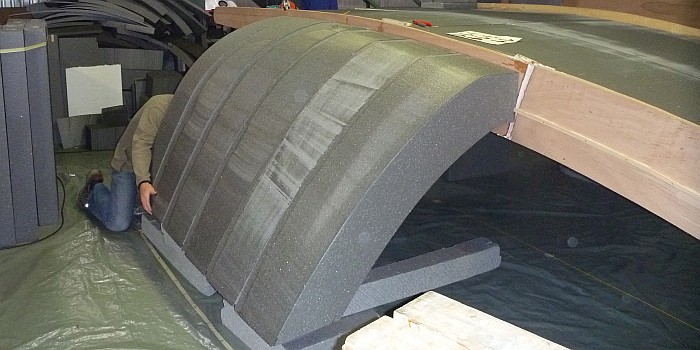
The passive igloo during construction.
The insulation fulfils both: a role of thermal insulation
and structural . Thickness 200mm.
The windows meet the compromise of sufficient visibility
during navigation, when weather is warm, and best performance
to limit heat losses during winter. Despite their excellent
quality with a U value of 0.5 W / (m²K), their performance
remains four times less than the surrounding superstructures.
Consisting of a triple glazing with two low-e layers and an
inert gas filling, they must also withstand high mechanical
stresses (navigation), impacts, and have a bond adapted to
extreme cold.

Laminated triple glazing used for windows.
Thickness 60mm.
Despite the excellent quality of the glazing, switching off
the heating during the rest periods resulted in the formation
of frost on the glazing when the temperatures in the cabin
dropped below 5° C at the end of the night. Rather than
to heat, this phenomenon could be solved by covering the windows
with 20-40cm of snow, in the manner of an insulating blanket.
The thermal conductivity of the snow was measured to 0.1W
/ (mK), which amounts to adding about 10 cm of a conventional
insulation.
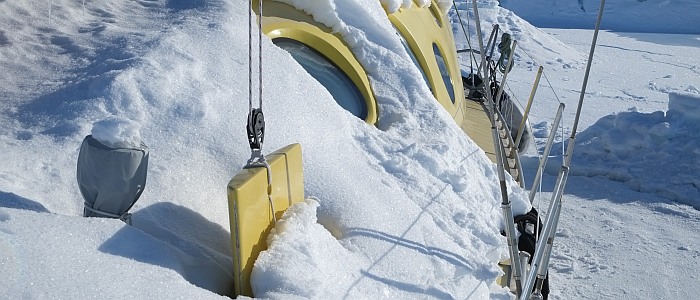
Snow: an effective and free addition.
Lambda thermal conductivity = 0.1 W / (mK). Thickness 20-40cm.
Photo in the spring (photo Peter Gallinelli)
Thermal zones::
Sleeping bags being comfortable down to below -20 ° C,
the sleeping quarters remained unheated. However, the formation
of condensation and frost forced us to include them in the
heated area, causing additional heat losses. Despite this
precaution, the weaker insulation of the cabins showed dew
points as soon as the outside temperature permanently dropped
below -15 ° C, mainly in the outside corners and under
the mattresses. Thermal zoning could only be moderate. In
our case the temperature in the cabins was on average 5°
C below the temperature in the living quarters with a strong
vertical temperature stratification.
The same reason can be used to explain why unheated entrance
locks do not work in cold weather. It will be discussed later.

Thermal zoning principle
Environmental heat:
The hull being immersed in relatively warm seawater (-1.6°
C) acted as a heat input. In the absence of occupants and
activities on board, the equilibrium temperature in the living
quarters stabilized at -10° C for an outside temperature
of -20 to -25 ° C (see trip to Qaanaaq). The effect was
most noticeable at the beginning of the winter with a buffer
zone temperature (bilge) close to 0° C. This would gradually
decrease to -10° C as the thickness of pack ice increased
(close to 2m around the boat) and the hull was pushed out
of the water trough sea ice pressure (50cm), see T_bilge of
the temperature graph. The boat played a role of insulating
cover: even at the end of winter the keel was still surrounded
by liquid water.
Conclusion :
Of all the systems, thermal insulation
was the most fundamental prerequisite for the project's success.
It is an unspectacular system but the only one that has worked
without intervention, without noise, and most of the time
without even thinking about it. It was easy to improve for
free with local materials: snow. Without reinforced insulation
the other systems all together would have been unable to supply
reasonable conditions for life on board.

Ventilation : 28% of the energy consumed
corresponds to the heat losses through ventilation
The diagram below shows the installation with the fresh air
intake and preheating with seawater (immersed tube) on the
left, the plate heat recovery system (in the middle) and the
warm cabin on the top right. The nomenclature of the temperature
probes will be used in the graphs below.

Installation in operation: example of
instantaneous values, typical winter day in December.
An efficient ventilation system must allow abundant ventilating
while keeping the heat inside. To meet this paradox a heat
exchanger is used to recover heat from the extracted air to
preheat the fresh air. A plate heat exchanger specially adapted
for use in the marine environment has been used.
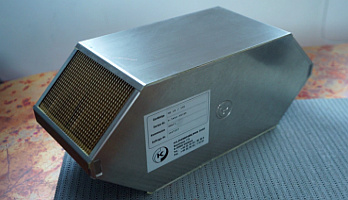
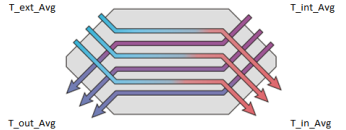
Countercurrent plate heat exchanger:
80% efficiency, 90% with condensation (Klingenburg data)
Two simple precautions have ensured its smooth operation
despite the extreme cold where a conventional heat exchanger
would have quickly frosted, become clogged and useless:
- preheating the cold air by a tube immersed in relatively
warm seawater (-1.6° C), and
- a bypass reducing the flow of fresh air through the exchanger
to maintain a positive temperature; the air deficit passed
through the immersed bilge of the boat before infiltrating
into the cabins. In the absence of an operational anemometer,
the fraction of fresh air deviated by the bypass was evaluated
to 20% (observation of the regulating valve).
The ventilation system has been set to recover sensible and
latent heat by condensation. The ventilation rate was regulated
depending on relative humidity of the air inside the cabin
with a minimum ventilation below 50% and maximum ventilation
above 80% relative humidity, rarely reached (only when cooking
food or on wake up in the morning). A occasional monitoring
of the CO2 level allowed an indicative verification of the
air quality, usually situated at the upper normative limit
(1500 to 2000 ppm, day, excluding cooking).
The geometry of the ventilation system had to be adapted
several times to prevent the formation of frost and ice. Water
from condensation inside the heat exchanger was directed into
a bottle. Being exposed to extremely cold outside air temperatures,
the air outlet also had to be adapted to prevent blocking
by formation of ice.
The submerged tube was very effective, but mechanically insufficient
to withstand the severe stress imposed by the ice and was
torn apart before the end of the winter. This is a point to
improve. In the case of a construction on land, this tube
would be buried.. It is mandatory when operating the recovery
system at temperatures below -5° C.
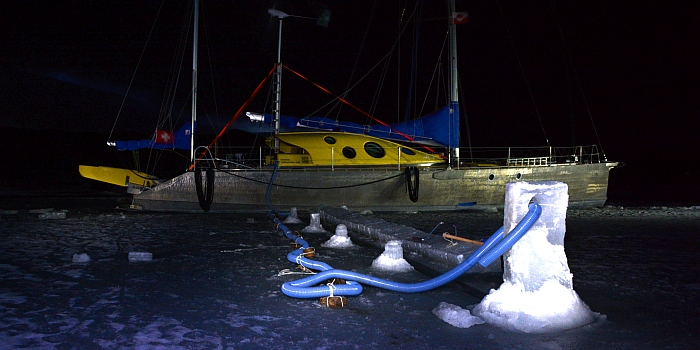
Site of the air preheating tube by seawater
before immersion. The stones are used to sink the tube: diameter
70mm, submerged length 20m (photo Kalle Schmidt)
The graphs below show the temperatures at the inputs and
outputs of the exchanger:
T_air: outside air temperature (blue)
T_ext: air after submerged tube, at the inlet of the exchanger
(purple)
T_int: indoor air, in the cabin (red)
T_out: used air expelled from the heat exchanger (grey)
T_in: air at the exit heat exchanger, as blown into the cabin
- excluding bypass (light blue)
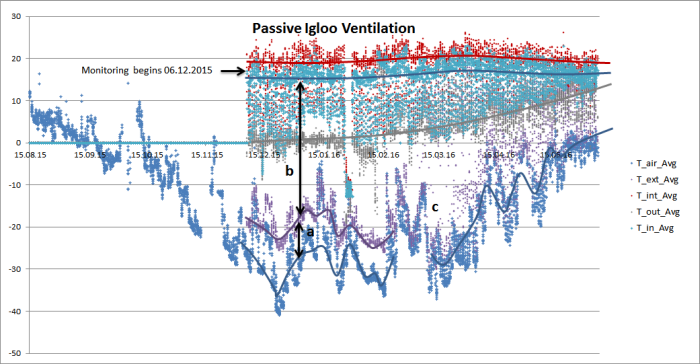
Overview of the ventilation system:
legend see diagram below ...
a) temperature gain due to the submerged tube
b) gain of the heat recovery system
c) submerged tube broken down at the end of February

Graph extracted over a week in early
January: legend see diagram below ...
Note: since the bypass is not connected to the air intake
tube in the cabin, the submerged tube failure does not affect
the temperature readings.
Unlike the initial project intending to make use of residual
heat at the outlet of the recovery system to produce drinking
water by melting ice or snow (see diagram above), the outlet
temperature was close to 0° C , too low to provide this
service. In return, the condensation water was collected in
the heat exchanger and used for washing hands.
Airlock and management of cold air inlets by door opening
:
To limit uncontrolled cold air intake, the initial project
included a winter entrance in the manner of an igloo tunnel.
Access was to be protected by a tent. After the violent storms,
the tents remained in their bags. It has also been found that
in very cold climates an entrance lock cannot be used to store
clothes. They must be dried in the heated zone at all times,
because even if perspiration is limited, the accumulation
of moisture is inevitable, making shoes and clothes gradually
ineffective.
We continued to use the usual insulated entrance door, however
reduced to a minimum opening of 60x60cm² located near
the floor, thus avoiding to release the hot air of the cabin
with each opening.
Water vapour management:
The gas stove (propane) and the kitchen are an important
source of vapours and odours. Also, to reduce over-ventilation,
we opted for low-temperature cooking, closed lids as much
as possible and made systematic use of the pressure cooker.
Odour management:
To preserve the quality of the air we gave up the traditional
oil lamp that can be found on many sailboats ... and in Greenland
homes. The toilets are equipped with an aspiration vent in
the composting unit which eliminates the unpleasant odours
at the base.
Conclusion :
Airtightness of the cabin (on a boat
that goes without saying) is essential to avoid the infiltration
of cold air. This sealing goes hand in hand with a ventilation
system because air quality is essential for the health of
the occupants, especially in confined spaces. We have been
able to show that a plate heat recovery system can be adapted
to very cold conditions and provide valuable service.

Heating
Mid-season:
The following graph shows a typical heating pattern for
the end of May when climatic conditions were comparable to
European winters with temperatures between -5° C and +5°
C. During this period, a brief operation of the heater at
the time of waking allowed to raise the cabin temperature
from 13° C to 19° C and to stabilize naturally around
20° C during the day. In a context where we do not consider
to sacrify thermal comfort, this is excellent news and probably
the most important.
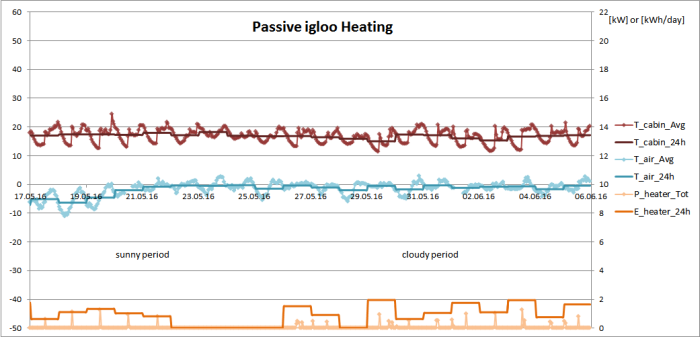
Graph from 17 May to 6 June 2016, a
period with temperatures comparable to the European winter,
between -10 ° C and + 3 ° C.
Winter:
Despite an unusually mild beginning of the year, the average
temperature was -26° C for the months of December to March
including three weeks with temperatures between -30° and
-40° C. During the winter 2015/2016 Greenland was swept
by heavy storms, with the exception of the Qeqertat region,
which experienced the most complete calms. Thus, from our
main wind-powered heating, we had to switch to 'plan B' and
rely on our propulsion fuel reserves to run the back-up system,
a forced-air diesel heater usually intended to dry the cabin
while sailing. The regulation is done by thermostat. The combustion
efficiency is 80%.
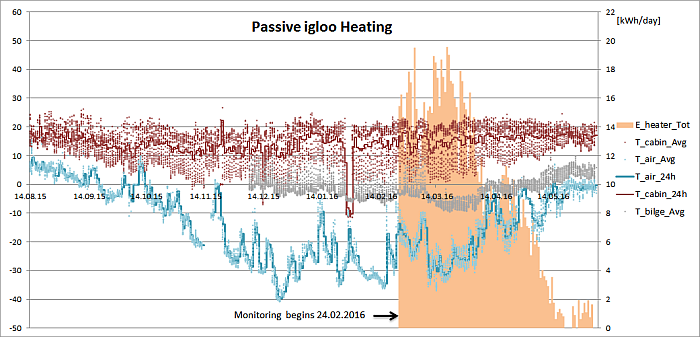
Winter 2015-2016 ; overview indoor and
outdoor air temperatures and daily heating energy
Despite the persistent lack of wind and the poor combustion
efficiency, winter heating consumption amounts to only 330
litres of diesel. This represents a fraction of the typical
Greenland homes in the Qaanaaq region (5-10 times less). In
the light of this observation, the goal of complete energy
self-sufficiency is possible, even in extreme cold climates
and without sun. Tthe wind generators operating under average
conditions, associated with a heat pump would have been sufficient
to provide 100% of thermal comfort(*).
(*) not available due to budget limitations.
The following graphs show the consumptions (on the left)
and the energy sources (on the right) represented in final
energy (before conversion) and useful (actually used):
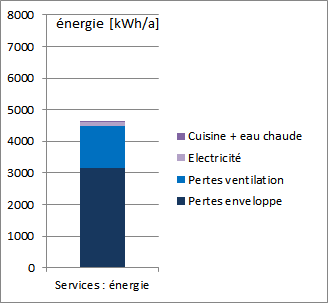
Energy by service |
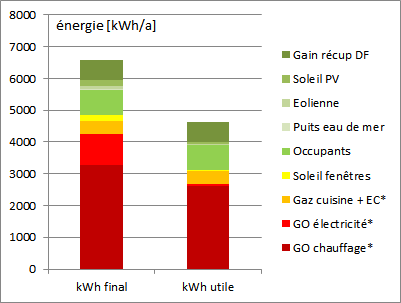 Heat contributions [*] conventional
energies in red-orange, renewable energies in shades
of green and yellow
Heat contributions [*] conventional
energies in red-orange, renewable energies in shades
of green and yellow |
Wind and solar energy provide small overall contributions
and one can point out the poor efficiency of electricity production
(see explanations below). A significant contribution was the
heat produced by the occupants. In normal operation, 2 to
3 people permanently lived on board. During periods with numerous
visitors, for example during visits where 6 to 8 people were
on board, the heating system systematically stopped, even
in very cold weather.
Finally, the simple fact of shutting down the heating system
during sleep has saved ~25% of the heating energy. Thus we
enjoyed a comfortable temperature during the day, close to
20° C, and comfortable rest between 0° and 5°
C in warm sleeping bags * (see graph below).
(*) comfort temperature -20°C

Typical temperatures during a week in
March: temperatures, power and heating energy.

Energy signature
The energy signature characterizes the energy consumption
as a function of weather. It allows to define the temperature
from which an additional heating is required. It is obtained
by relating power or heating energy to the average daily outdoor
temperature, cf. graph below.
In very cold weather, the readings show that a heating power
of 300W per occupant is necessary to ensure comfort; 50W per
occupant is enough for periods that are comparable to climates
comparable to those in Central Europe. This is very little
and can easily be provided by renewable energies, which means
energy self-sufficiency.
The trend line places the non-heating temperature at the
intersection with the abscissa at +4° C. In practice,
above 0° C daily average temperature, no heating was required.
As a reminder: the average winter temperature in Central Europe
is above 0° C!
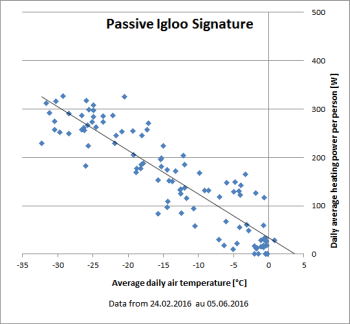
Average daily temperatures versus average
daily heating power per occupant.
The performance of the passive igloo is highlighted by comparing
it to a dwelling built according to the mandatory standards
in Switzerland (limit values according to SIA 380/1):

SIA Geneva corresponds to a dwelling that has the same size
as the passive igloo, built according to regulations in the
climate of Geneva; SIA Thule is the same house in Arctic climate.
It is fairly representative of small Greenlandic houses imported
from Denmark.
SIA Genève 150m² corresponds to a dwelling whose
living space respects the recommendation of the Swiss regulations
for 2.5 inhabitants; SIA Thule 150m² is the same house
in Arctic climate.
Conclusions :
Designed according to the principles
of the passive building for temperate climates, the passive
igloo has shown that active heating is not necessary when
temperatures are above 0°C. A 'warm spot' remains however
desirable by allowing to meet temporary needs of physiological
or psychological order.
At a first approach, insulation should
limit transmission losses to less than 100 W per inhabitant.
The average U-value of the building envelope is calculated
by dividing this value by the difference between the design
indoor temperature and the average temperature of the coldest
week (winter) and the building envelope area per inhabitant.

Electricity : 4% of energy
Of course the boat could not be connected to any electrical
network. The limited availability of electrical energy has
forced us to optimize our electrical household: careful and
sober use, elimination of unnecessary and parasitic consumers,
charging nomadic devices only during periods of availability,
direct low voltage use wherever possible, otherwise by high
efficiency inverter (230V AC).
The daily consumption could thus be limited to only 0.5 kWh
for a 'household' of 2.5 occupants, which includes almost
permanent fixed and mobile lighting (head lamps), the ventilation
system, the power required by the forced air heater, scientific
instruments, two computers, music and various nomadic devices
as shown below.
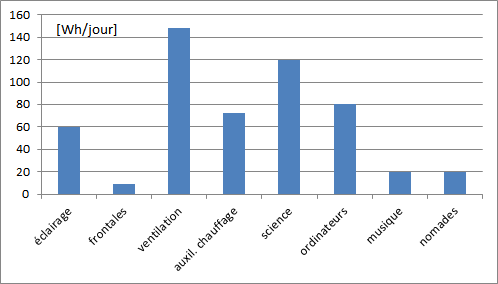
Daily electric balance chart (winter)
The following systems have contributed to providing the necessary
electrical energy:
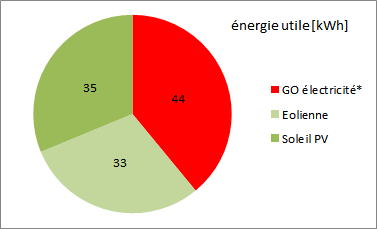
Electricity consumption for the period
of October 2015 to June 2016
Overview of the electrical system:
- wind: two-blade three-phase AC wind generator 1.5kW, 24V
+ an identical wind turbine for back-up
- sun: 4 mono crystalline solar panels of 50 Wp each, 12V
+ MPPT regulator (maximum power point tracker)
- back-up (diesel electricity): alternator on propulsion
motor 24V, 30A (point to improve)
- batteries: lead acid, liquid electrolyte 6x 4V 550Ah @
C20, series mounting
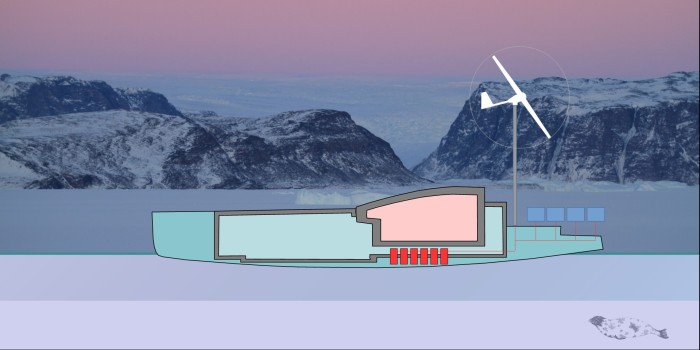
Back-up :
In the absence of wind and sun (Arctic night from October
to February) we had to make use of the propulsion engine alternator
for an almost daily charge of 30 to 45 minutes at 700W ...
a very inefficient way to produce electric power. It would
have been better to produce electricity with a dedicated heat-force
coupling system, i.e. a small diesel, gas or petrol genset
with recovery of combustion heat for space heating. The difficulty
inherent to these systems is the need to find a very small
model, < 800W of thermal power, and limited reliability.
With the return of the sun end of February there was abundance.
The small photovoltaic plant was largely sufficient to cover
all the needs. From that moment, cooking was made on an electric
induction plate, advantageously replacing the gas cooker.
Being excess production, this consumption does not appear
in the above accounts.

(application twilight,
clear sky model)
Conclusions :
Without electricity, few present-day
systems would work. In absolute quantity, electricity represents
a small amount of energy if produced and used with intelligence.
To ensure self-sufficiency, good complementarity of resources
is necessary. Anticipation and prior knowledge of local resources
are particularly important. This knowledge was lacking; for
the region that concerns us it just did not exist. Despite
these uncertainties, two thirds of the electricity needs have
been provided by renewable energy sources (wind and photovoltaics).
Daily life

Kitchen, water and hot water: 1.5% of energy
consumed
Cooking and hot water were either made on an induction plate
or a gas cooker powered by liquid propane in bottles, such
as purchased in Greenland. The bread was baked once a week
in a conventional gas oven. Due to the limited availability
of electricity, the induction plate has been little used during
winter. Most of the energy came from our stock of gas bottles,
two 10kg bottles. An unnoticed gas leak cost us an extra bottle.
Solid or liquid fuel would be more reliable, but much less
convenient.
Notes on optimizing cooking:
Among the efficiency measures, we implemented cooking methods
that significantly reduced gas consumption while avoiding
the unnecessary production of water vapour. The pressure cooker
has proved essential. It is the most efficient way to reduce
consumption by a factor of 2 to 4.
Energy being limited, it was necessary to make the best use
of it. To find out, we carried out comparative tests to bring
1 litre of cold water to boiling. The theoretical heat is
obtained by calculation.
With an efficiency of 85%, induction cooking proved very
interesting. This mode of cooking is best adapted to renewable
electricity (wind, sun, ...) provided that it is available
locally and in abundance. This was our case - when there was
wind or sun. For power supply one should consider the losses
of storage (batteries ~ 70%) and conversion (inverter ~ 90%).
When electricity is of thermal origin (power plant or genset),
the numerous transformations and transport make this system
potentially unefficient (15% to 20% overall efficiency) and
technically fragile (irreparable with on-board means).
The efficiency using the gas cooker amounts to only 15%,
but all the heat from cooking is beneficial to space heating.
In the end a not so bad solution. We also tested the various
plates (different diameters and powers), to associate with
each pan the fire that had the best performance: a little
saucepan on a big fire makes the flames go by; conversely
a large saucepan over a small fire lengthens the cooking time
disproportionately. Potential gain 10%.
The appropriate casserole:
Induction cooker: preferably use a lightweight pan with an
induction base (ferrous). It is possible to wrap the pan into
a blanket, even when cooking. Gain 10% to 20%.
Gas cooker: preferably use a cast iron pan. It will recover
some of the heat lost on the edges and avoids burning the
contents (thermal conduction by the edges). Gain 10 to 15%.
Fresh water:
The possibility of finding liquid drinking water in a nearby
lake was invaluable, avoiding the need to melt ice, a very
energy-intensive process.
There was no running water on board, neither cold nor hot.
The shower was done with a sop and a basin filled with hot
water: simple, effective, economical. Natural soaps limit
water consumption and pollution.
All in all, water consumption was 5-6 litres per person per
day, much of it for hot and cold drinks to hydrate ourselves
due to the very dry air of the Arctic.
Water was collected once or twice a week and stored in an
80-liter PE drum, placed in the warm and frost-free zone.
In addition, chunks of ice were melted to lengthen the water
collection intervals. This method is directly inspired by
local habits and customs.
Conclusions :
The potential for efficiency gains
is very large. However, cooking represents a small part of
the total consumption. The choice of suitable equipment and
good praxis are enough.

Laundry: 1.5% of energy consumed
During the first weeks, while we were cut off from the world,
we did the laundry on board, in small quantities to allow
drying inside the heated cabin. Once the link to the close
by village was restored we took advantage of the communal
laundry room.

Waste management and toilets
Waste management was first approached by promoting bulk or
large quantities of packaging, thus limiting the amount of
packaging. Then by a selective sorting: glass, metal, paper,
incinerable and organic matter.
The most important point was a strict separation of the organic
matter from the rest, the prerequisite to allow storage over
time without being inconvenienced by the development of bad
odours.
The dry composting toilets are worth mentioning since they
have been a real success. In particular the odour management,
incomparably better than any conventional toilet, was remarkable.
At the same time, the composter 'ate' the kitchen scraps
and pieces of paper and cardboard that were used to provide
composting in the absence of conventional materials (sawdust,
wood chips, ...). Thus, through rigorous sorting and the efficient
management of compostable materials, less than a bag of 20
litres of dry and clean incinerable waste were produced per
month. These could be stored indefinitely while waiting for
the next call to a place equipped with appropriate waste handling
facilities.
The composter contents were transferred every 3-4 weeks into
a bag stored outside and so immediately frozen. As soon as
summer came back, the post-composting was done at the foot
of a sunny and warm rock with an abundant and opportunistic
fauna of flies and worms. Compared to a flush toilet system
(a), this system has avoided producing 18'000 litres of problematic
black water impossible to manage in the long term. Extrapolated
to 12 months, this represents less than 200 litres of fertile
compost that could be returned to the environment and 1000
litres of urine collected and assimilated in small quantities
into seawater (b). Quantities apply for a crew of 2.5 people
on average.

Comparative WC (a) - TS (b) for one
year and 2.5 people: 1 cube = 1000 litres
The model used on board are dry toilets of the market. They
deserve some improvements in ergonomics including the urine
separation device and the handling of the compost bin.
All that remains were metals, glass and some plastic containers.
Once cleaned and compacted these materials were stored and
carried to the first available recycling point. The volume
and the weight were no problem, being in all cases well below
the initial volume shipped.
Conclusions :
The constraints made us take an important
step towards composting toilets which proved to be very suitable
despite our situation which does not predispose to this type
of system, in particular because of the cold which is not
favourable to the processes of biological transformation.
During navigation, we still use the
classic marine toilet system (flush seawater), more suitable
to absorb the flow of a variable and numerous crew.
Finally, the notion of waste should
be substituted by 'recyclable materials'. If properly managed
from the beginning it is a non-problem.

Nutrition and more
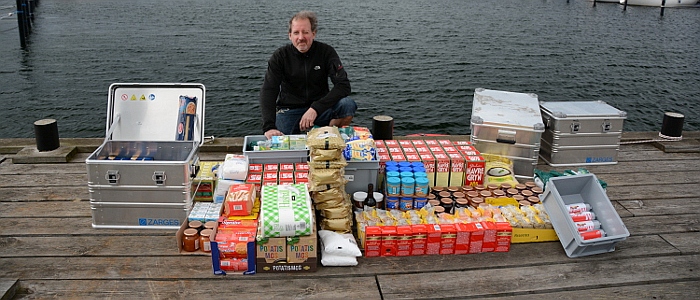
Provisioning in Malmö: second third
of food for one year (photo Kalle Schmidt)
Providing food for 12 months is not a simple task. It represents
nearly a ton of food that must be stored for a long time and
allowing a healthy, complete and balanced diet. Half of it
was used by the the summer crews (10 persons for 2 months),
the rest by the winter crew (2 persons for 10 months).
Not being enthusiasts of freeze-dried and pre-cooked or frozen
food, we found inspiration in the traditional cuisine based
on legumes and cereals, the most complete possible. Dried
fruits, vegetables and mushrooms brought variety, as well
as a very complete assortment of spices.
An additional caloric basis consisted of honey, olive oil,
butter and a big cheese wheel. Cabbage and fresh onions were
kept until February. With the return of the sun we were growing
seeds.
To avoid the risk of a vitamin deficiency we supplemented
our diet with a daily vitamin capsule and vitamin D during
the night months. Finally, a fish or occasional hunt contributed
to an exemplary diet. The best proof: we have not developed
any culinary fantasy ...
Conclusions :
Simple and adapted solutions do exist.
It is necessary to leave the habits of the precooked dish.
Conservation has been the key to our diet. Many solutions
exist since the dawn of time. They are sound sources of inspiration.
Excerpt from the logbook "Today,
June 20, fresh food makes us dream. The supply ship from Denmark
will arrive in two weeks!"
Isolation
We were prepared for isolation. The key word was self-reliance,
from the level of knowledge to carrying out the project, skills,
tools and spare parts to repair just about anything. However,
we underestimated the importance of carrying reference books
and dictionaries. Not being equipped with satellite communication
systems, the toughest was the period of icing in where we
were cut off from the world during 3 months of which 2 without
being able to leave the perimeter of the boat.
Darkness
Contrary to popular belief, it is not night for four months.
There are magnificent twilights, moonlight, stars, and sometimes
aurora borealis to brighten up the sky. All on a background
of snow and ice that amplify the light. But this spectacle
is only visible for those who do not abuse of artificial lighting.
Thus we experienced the return of the sun not as a liberation,
but rather as the augury of a new chapter, as exciting as
the previous ones.
See twilight...

Conclusions
There are still some things to improve,
there always will be(!), but the 'passive igloo' experience
shows that it is possible to create a habitat that is close
to self-sufficient in terms of energy supply while remaining
simple and affordable for the coldest climates on earth.
An outstanding thermal insulation is
the basis of a comfortable and durable habitat. This is a
prerequisite on the way towards renewable energies. It is
also a life-insurance in case of supply problems because it
makes implementation towards alternatives possible and affordable.
The expedition was a laboratory in
a hostile environment that does not allow any missteps. At
times the commitment was complete and required absolute reliability
of the systems. The only ones to be perfectly reliable were
the passive systems, to begin with the thermal insulation.
We were able to experiment each subsystem
in detail in the context of the harsh conditions of real-world.
And in turn each system has been pushed to and beyond its
limits.
Finally, the passive igloo was a most
demanding scenario because of its small size and subjected
to innumerable additional constraints related to the marine
environment - after all it is also a sailboat. Therefore,
what has been possible for the passive igloo will be much
easier for a land based construction. And the bigger the construction,
the easier it will be to achieve these goals because the form
factor is favourable.
Due to experience and good preparation
we have never suffered from the cold. Whether it's the boat
or the clothes, the organization or the equipment to cope
with the cold, everything has added to make the winter a pleasant
and rewarding experience at any time. But we also learned
from local people. The most beautiful sign of confidence in
what we were doing was entrusting their children to spend
the night aboard.
Today, we are looking forward to build
on the experience of the passive igloo, by developing the
concept around self-sufficient terrestrial habitats in the
Arctic or in the high mountains.

How to go further?
Heating energy accounts for almost half of the primary energy
imported into Switzerland. The situation is comparable in
other European countries.
Knowing the limits of non-renewable energies and the harmful
effects on the environment of their inconsiderate consumption,
it is an important lever on which we must act. And we can:
The experience of the passive igloo shows that it is possible
to reduce this consumption drastically. This knowledge is
applicable to any new construction. The responsibility to
ensure the implementation rests with all actors: communities,
project owners, architects, builders, operators, inhabitants.
Teaching has an important role to play too.
Built to these standards of design, the buildings of the
future will not only be more ecological. They will also be
more resilient, capable to adapt to the uncertainties and
surprises that the future holds for us. The prerequisite will
be simplicity, synonymous of economy and sustainability.
High efficiency is a prerequisite on the way to renewable
energies: it is much more economical and ecological to reduce
needs than to build ever bigger solar farms, wind farms, dams
...
|
|
The arrows on houses represent the
energy needs for heating,
hot water and electricity.
At equal service, efficiency measures aim to reduce
needs.
Self-sufficiency means substitution with renewable
energies.
The combination of both is necessary to achieve
efficient and affordable homes.
Sobriety questions our real needs. More quality
and less quantity.
|
There is no valid excuse for not making contemporary buildings
energy self-sufficient. It is all the more urgent since these
buildings will probably still exist in a generation or two,
in a future where 'easy' energy will be past.
Only simple and robust solutions with a short ecological
return time will have to be used to achieve this goal. These
buildings will distinguish themselves neither by their appearance
nor by their cost of construction. Passive devices, insulation
first, are neither spectacular nor sophisticated. It is as
simple as integrating the right strategies from the beginning.
They are an essential project condition. A building must not
only withstand gravity, use and boredom (firmitas, utilitas,
venustas *), it must also withstand time and the future.
[*] Vitruvius: strength, utility, beauty
The difficulty of rehabilitating existing buildings that
have become obsolete shows how important a proper vision for
the future is. This is also important to ensure the sustainability
of real estate investments. It shows that there is no time
to waste. We must act today.
If our world is not yet ready to make concessions on quantity,
sobriety will become a most important lever. This cannot be
achieved without providing quality. It's about cultivating
quality before quantity, a paradigm shift.
Often the fear of change is more painful than the change
itself. But this change is possible.
Peter Gallinelli, Greenland, Nanuq's cove,
June 2016

|